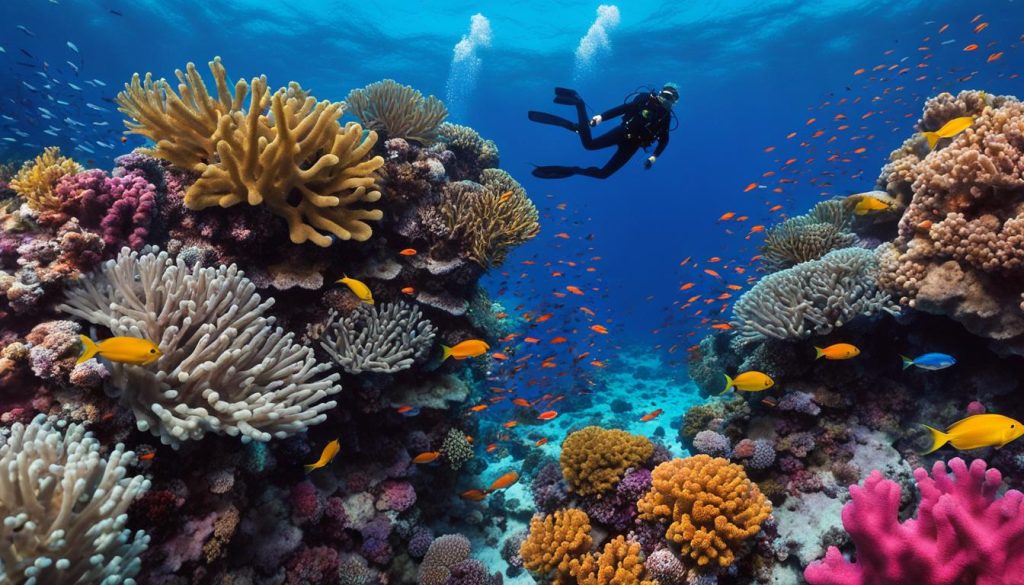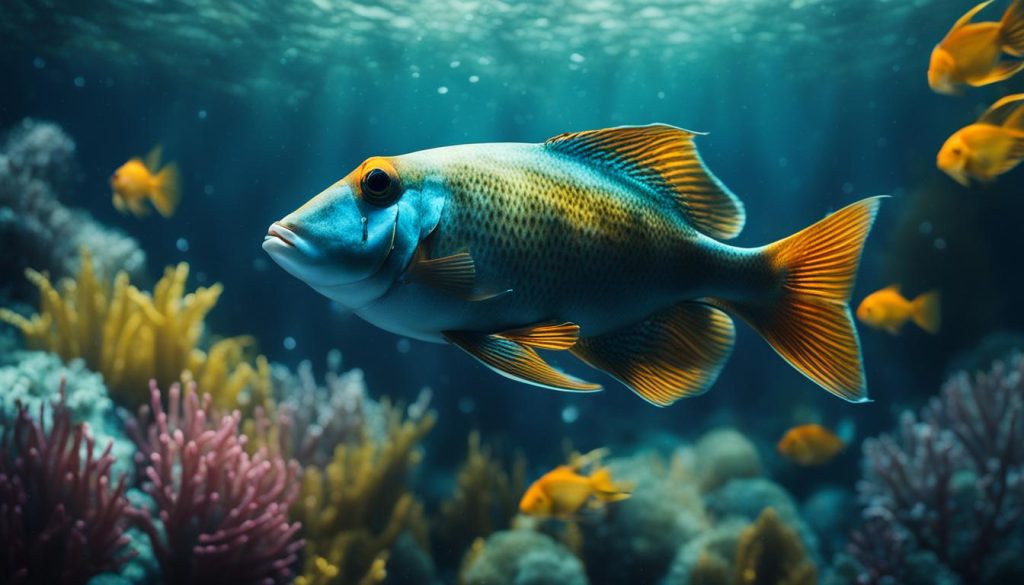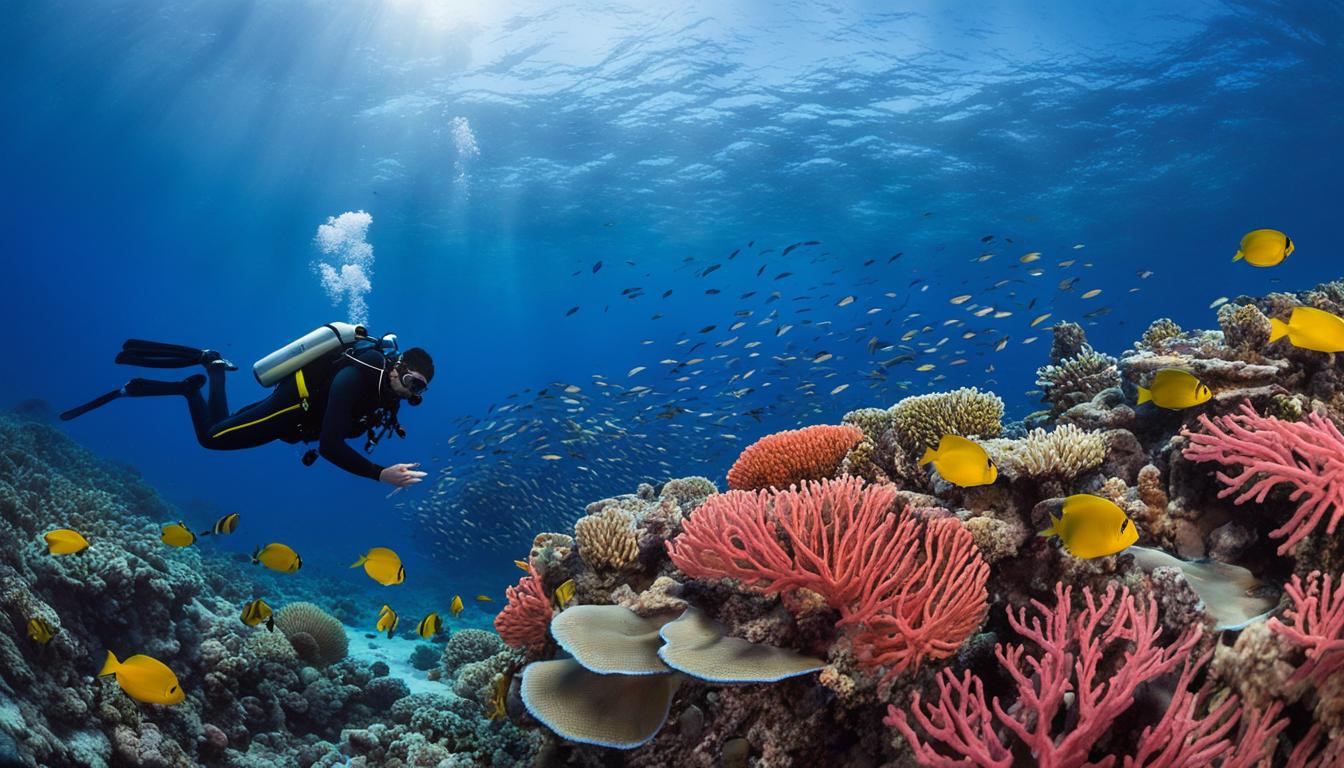Underwater photography is a captivating art form that allows us to explore the vibrant and diverse world below the surface. It offers a unique perspective on aquatic life, capturing the beauty and wonder of underwater environments. From colorful coral reefs to majestic marine creatures, underwater images transport us into a realm filled with awe and fascination.
Key Takeaways:
- Underwater photography provides a unique perspective on aquatic life.
- It captures the vibrant colors and diversity of the underwater world.
- Exploring underwater environments offers a sense of awe and wonder.
- Photographs can transport viewers into a captivating realm.
- Underwater images showcase the beauty and importance of preserving our oceans.
The Right Gear for Underwater Photography
To capture high-quality underwater images, it is essential to invest in the right gear. Many photographers recommend using reliable brands like Canon and Aquatech. The Canon 5D Mark IV is a popular choice for underwater photography, paired with lenses like the 35mm f/1.4L ii and EF 14mm 2.8L. Aquatech water housings are also highly recommended for their reliability and ease of use. It is crucial to choose the gear that feels right to you and allows you to capture images that reflect your unique style.
When it comes to underwater photography gear, the Canon 5D Mark IV stands out as a top choice for enthusiasts and professionals. With its exceptional image quality and advanced features, this camera delivers stunning results in challenging underwater conditions. Paired with high-quality lenses like the 35mm f/1.4L ii and EF 14mm 2.8L, you can capture detailed and vibrant underwater images that showcase the beauty of aquatic life.
Alongside a reliable camera, investing in a suitable water housing is crucial to protect your gear and ensure optimal performance underwater. Aquatech is a renowned brand known for its innovative and durable water housings. Their housings are designed to provide easy access to camera controls while providing a watertight seal to keep your camera safe at varying depths.
When it comes to choosing the right gear for your underwater photography adventures, consider your personal preferences and shooting style. It’s important to feel comfortable and confident with the equipment you use, as it will allow you to focus on capturing incredible images under the sea.
Playing with Light in Underwater Photography
Light is an essential element in underwater photography. Harnessing the beauty of natural light can elevate your underwater images to a whole new level. When photographing underwater, it is often best to rely on natural light, especially during specific times of the day when the water is calmer and soft natural light is available.
To maximize the potential of natural light, it is crucial to position yourself in a way that allows the sun to be behind you. This positioning helps create the best lighting conditions, illuminating the subject and enhancing the colors and details in your images.
Controlling the ISO settings is another key aspect of working with light underwater. Keeping the ISO low is essential to minimize noise and backscatter in your images. For most situations, it is recommended to use an ISO setting of 100. This low ISO allows for cleaner, sharper images, capturing the natural colors and details of the underwater world.
However, on cloudy days or in situations where natural light is limited, increasing the ISO to a range of 400-640 can be beneficial. This adjustment helps compensate for the lack of light and ensures your images still maintain the desired quality and clarity. It is important to strike a balance between ISO and lighting conditions to achieve the best results.
“Underwater photography is all about understanding and playing with light. Embrace natural light, position yourself wisely, and control the ISO to capture breathtaking underwater images.”
Best Lighting Conditions for Underwater Photography
While natural light is preferred, there are specific lighting conditions that can enhance your underwater images:
- Golden Hour: The period shortly after sunrise or before sunset provides soft, warm light that adds a magical touch to your photos.
- Dappled Light: When the sunlight filters through the water’s surface, creating captivating patterns and highlighting the subject.
- Blue Hour: The time just before sunrise or after sunset when the water takes on a deep blue hue and offers a serene backdrop for your images.
Experimenting with various lighting conditions and learning to adapt your techniques accordingly will help you capture stunning underwater photographs that showcase the beauty of the aquatic world.
Now that we have explored the importance of light in underwater photography, let’s move on to mastering buoyancy control, an essential skill for capturing captivating underwater images.
Mastering Buoyancy Control for Underwater Photography
Buoyancy control is a critical skill that every underwater photographer must master to capture stunning images. Whether you are a beginner or an experienced diver, understanding how to control your buoyancy underwater is essential for stability, precision, and safety.
One effective technique for achieving buoyancy control is wearing a weight belt. A weight belt helps you maintain proper buoyancy by counteracting the natural buoyancy of your body and equipment. By adjusting the weight on the belt, you can find the perfect balance, allowing you to stay at the desired depth effortlessly.

Another method to master buoyancy control is by practicing lung-emptying techniques. By exhaling deeply and emptying your lungs, you can become more compact and dense, enabling you to sink more easily. This technique requires practice and breath control but can significantly improve your ability to control your depth underwater.
In addition to weight belts and lung-emptying techniques, the right equipment plays a crucial role in buoyancy control. Fins and a mask are essential gear for any underwater photographer. Fins provide the necessary propulsion and maneuverability, allowing you to position yourself accurately for the perfect shot. A mask not only protects your eyes and provides a clear field of vision but also helps you equalize the pressure in your ears as you descend and ascend.
While all these gear elements are important, many underwater photographers consider a weight belt to be the most crucial. It provides better stability and control, allowing you to focus on composition and capturing those incredible underwater moments.
To summarize, mastering buoyancy control is vital for underwater photographers. By wearing a weight belt or practicing lung-emptying techniques, you can achieve better stability and control underwater. Combine this with the right fins and mask, and you’ll be well on your way to capturing breathtaking underwater images.
Developing Your Signature Style in Underwater Photography
Developing your unique photography style is an essential aspect of underwater photography. While it’s crucial to appreciate and learn from other photographers, it’s equally important to capture images that reflect your vision and bring you joy.
Avoid replicating images that are similar to what everyone else is capturing. Instead, focus on photographing what truly resonates with you and what you want to see. By doing so, you can create a collection of underwater images that are distinct, captivating, and stand out from the crowd.
Developing a unique photography style allows you to showcase your personality and perspective through your work. It helps you create a body of work that is both visually appealing and reflective of your artistic vision. Whether it’s the use of vibrant colors, unconventional compositions, or a particular focus on marine life, your signature style will make your images instantly recognizable.
Experimentation is key when developing your photography style. Take the time to explore different techniques, angles, and lighting conditions. Embrace your curiosity and allow yourself to push the boundaries of traditional underwater photography. By stepping outside your comfort zone, you’ll discover new perspectives and possibilities that will contribute to the development of your unique style.
“Your photography is a reflection of you. Let your style be a true representation of your vision and passion for the underwater world.” – Laura Evans
When developing your signature style, don’t be afraid to take inspiration from a variety of sources. Look for inspiration beyond underwater photography itself, such as art, nature, or fashion. Draw inspiration from different photographers and genres, and adapt those influences in unique ways to craft your own distinct approach.
Remember, developing a photography style is a journey that evolves over time. It’s not something that can be rushed or forced. Allow yourself the freedom to grow and evolve as a photographer. Embrace constructive feedback and continue to refine your skills to achieve the level of excellence you aspire to.

Examples of Unique Underwater Images
| Photographer | Description |
|---|---|
| David Doubilet | An award-winning photographer known for his compositions that blend underwater and terrestrial elements. His images often feature dramatic lighting and captivating perspectives. |
| Jennifer Hayes | A renowned photographer specializing in marine wildlife. Her images beautifully capture the grace and elegance of marine creatures in their natural habitat. |
| Thomas Peschak | A National Geographic photographer recognized for his ability to document marine conservation efforts. His images convey powerful messages and inspire action to protect our oceans. |
These photographers have developed their unique style by honing their skills, exploring creative techniques, and capturing images that are personally meaningful to them. Take inspiration from their work and use it as a catalyst to develop your own signature style.
Shooting Techniques and Preferences in Underwater Photography
When it comes to underwater photography, shooting in manual mode is highly recommended. Manual mode provides photographers with full control over their images, allowing for better post-production editing. By adjusting the aperture, shutter speed, and ISO settings, you can achieve the desired exposure and capture stunning underwater shots.
One of the benefits of shooting in manual mode is the ability to reduce post-production editing. When shooting in RAW format, the images captured retain their natural colors and require minimal adjustment to the white balance. This saves time and ensures that the final image accurately represents the underwater scene.
The advantage of shooting in RAW format extends beyond post-production editing. RAW files contain all the data captured by the camera’s sensor, providing greater flexibility in adjusting exposure, contrast, and color temperature during editing. Unlike JPEG files, RAW files do not undergo compression, preserving the image quality and allowing for more significant adjustments without loss of detail.
Shooting Techniques for Underwater Photography:
- Experiment with different camera angles and perspectives to capture unique and captivating underwater images.
- Use the camera’s autofocus and manual focus modes to ensure sharpness in your subject.
- Take advantage of burst mode to capture fast-moving aquatic life.
- Utilize the rule of thirds to compose visually appealing underwater shots.
Remember, underwater photography is an art form that requires practice and experimentation. Don’t be afraid to try new techniques and develop your own shooting preferences to create stunning images that reflect your unique style.
“The ability to shoot in manual mode and capture images in RAW format gives underwater photographers complete control over their creative vision.” – Jane Thomas, Professional Underwater Photographer
| Advantages of Shooting in Manual Mode | Advantages of Shooting in RAW Format |
|---|---|
|
|
Conclusion
Underwater photography is an incredibly rewarding form of art that allows you to capture the breathtaking beauty of the aquatic world. To improve your underwater photography skills, it is crucial to invest in the right gear. Brands like Canon and Aquatech offer reliable options, such as the Canon 5D Mark IV camera and Aquatech water housings, which are highly recommended for their durability and performance.
Understanding light is another key aspect of underwater photography. Utilize natural light whenever possible and position yourself so that the sun is behind you to achieve optimal lighting conditions. Additionally, controlling your ISO settings, keeping it low to minimize noise and backscatter, will ensure clearer and more vibrant images.
Buoyancy control is an essential skill to master when capturing underwater images. A weight belt can provide better stability and control, allowing you to focus on composition and capturing memorable shots. Develop your signature style by exploring your unique vision and shooting what brings you joy. Remember, your perspective is what sets your images apart and makes them truly special.
Utilize shooting techniques like manual mode and shooting in RAW format to have full control over your images and enhance your post-production editing capabilities. This will enable you to bring out the natural colors and details of your underwater photographs. Moreover, continuous practice and seeking feedback from experienced photographers will help you refine your skills and create stunning images that showcase the wonders of aquatic life.
FAQ
What gear do I need for underwater photography?
Investing in reliable brands like Canon and Aquatech is recommended. The Canon 5D Mark IV paired with lenses like the 35mm f/1.4L ii and EF 14mm 2.8L is a popular choice. Aquatech water housings are also highly recommended for their reliability and ease of use.
How does light affect underwater photography?
Light plays a crucial role in underwater photography. Natural light is often preferred, especially when the water is calmer and soft natural light is available. Positioning yourself with the sun behind you helps achieve the best lighting conditions. Keeping the ISO low minimizes noise and backscatter in your images.
What is the importance of buoyancy control in underwater photography?
Buoyancy control is a critical skill for underwater photographers. Wearing a weight belt or mastering buoyancy control by emptying your lungs helps achieve better stability and control while capturing images. Fins and a mask are essential, but many photographers consider a weight belt to be more important.
How can I develop my own style in underwater photography?
Developing your signature style is essential in underwater photography. While it’s important to learn from others, focus on capturing images that reflect your vision and bring you joy. Avoid shooting images that are the same as everyone else, and instead, photograph what you want to see. This will help you create unique and captivating underwater images.
What shooting techniques are recommended for underwater photography?
Shooting in manual mode is highly recommended as it provides full control over your images and allows for better post-production editing. Shooting in RAW format is advised as it offers flexibility in post-production editing and ensures no compression of image files.
How can I improve my underwater photography skills?
By investing in the right gear, understanding light, mastering buoyancy control, developing a unique style, and utilizing shooting techniques like manual mode and RAW format, you can elevate your underwater photography skills. Practice and seek feedback from experienced photographers to continuously improve your abilities and capture the wonders of aquatic life through your lens.






